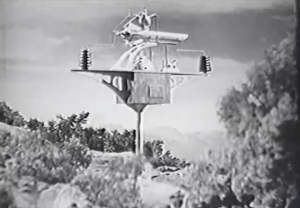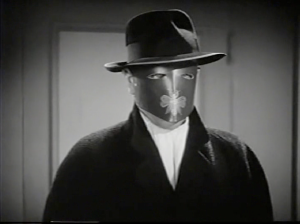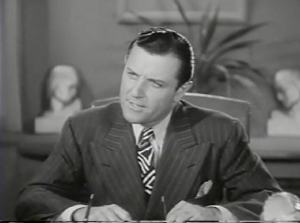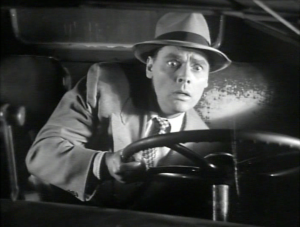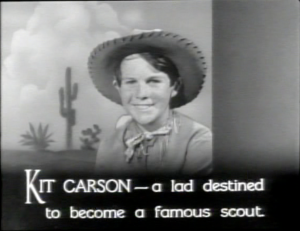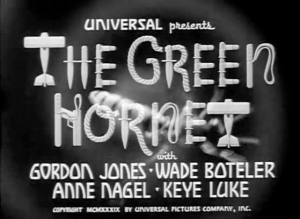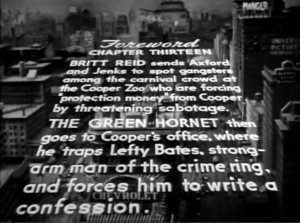On land or sea in polar night
Or sweltering tropic scenes
Where e’er there’s fighting
You will find U. S. Marines.
–introduction to The Fighting Marines
The action of The Fighting Marines begins in media res (unusual but not unheard of for serials): Corporal Larry Lawrence (Grant Withers) and Sergeant Mack McGowan (Adrian Morris) of the U. S. Marine Corps are battling a gang of bandits in a jungle, trying to rescue their friend and fellow Marine, Sergeant William Schiller (George J. Lewis). Schiller is the inventor of a new “gyro compass,” and the bandits hope to learn its secret from him. After Schiller’s rescue, the real story begins: Schiller’s gyro compass will make it possible for the Marines to build a base on remote Halfway Island in the Pacific Ocean. So far, the island has been inaccessible because of a “magnetic dead spot” that causes ships and planes to crash short of the island. A businessman named Douglas (Robert Frazer) hopes to build a floating airstrip outside of the dead spot, and he stands to lose a fortune if the Marines succeed in building on the island.
At the same time, unbeknownst to the Marines, Halfway Island is being used as a base by a notorious pirate known only as the Tiger Shark. As in Batman and Robin and Government Agents vs. Phantom Legion, even the Tiger Shark’s own men don’t know their boss’s identity, but they refer often to those poor suckers in the organization who had tried to find out, or who had tried to claim their shares of the loot before the Tiger Shark was ready to dispense them.
It is the Tiger Shark, who always appears in a fashion-forward leather flying suit and goggles, who is responsible for the dead spot, employing a “magnetic ray gun” to scramble approaching planes’ instruments. In addition, the Tiger Shark seems to know too much about the Marines and their operations, even before Larry and Mack are able to land on the island and discover the pirate’s base. It’s strongly implied that Douglas is the Tiger Shark, but could it be Buchanan (Frank Glendon), the head of the Oriental Navigation Company, who also has an interest in the region? Or could it be someone even closer to the Marines? Needless to say, the mystery is teased out until the very last chapter, when the villain’s identity is revealed.
I have to admit that I probably wouldn’t have gone out of my way to watch The Fighting Marines if I weren’t writing this series. Aside from its lack of recognizable characters, I wasn’t really sure what to expect from the title sequence, which combines Sousa’s “Semper Fidelis” march with stock footage of Marines in dress uniforms marching in parade formation. The premise seemed to suggest either a war movie (a genre I don’t usually go out of my way for) or, worse, high jinks on a military base. I needn’t have worried: with a few exceptions, The Fighting Marines is pure serial formula, from its mysterious costumed villain to his army of interchangeable henchmen and the gauntlet of fist- and gunfights, car chases, and other perils that the heroes face.
There is also a distinctly pulpy, futuristic edge to the Tiger Shark’s equipment, although it is mostly limited to his base on Halfway Island. In addition to the magnetic ray gun, the Tiger Shark’s forces use television to communicate. However, unlike characters in other serials, the Tiger Shark’s henchmen must wear an elaborate headgear to use the television, whether necessary to make the technology work, like a radio headset, or simply to disguise their identities, I don’t know. Television is so often treated like a kind of magic in films of the 1930s that it shouldn’t be surprising that it requires a special costume to use it, like the ephod worn by the priest who handled the Ark of the Covenant. In some ways the ray gun and other high-tech gadgets make The Fighting Marines an early example of “spy-fi” à la James Bond or The Man From UNCLE rather than a purely military escapade.
Other elements beside the costumed villain and his high-tech toys suggest similarities with other serials: although the two heroes are Marines under the authority of their Colonel (Robert Warwick), and wear uniforms and report to the Marine base, and even in a few chapters take part in military operations with larger squads, they mostly work on their own, with a free hand to track down clues and take on the bad guys by themselves. The format of their adventures isn’t that different from those of the independent agents in Robinson Crusoe of Clipper Island or The Miracle Rider, or the team of unofficial deputies in Daredevils of the Red Circle (or an episode of JAG, for that matter).
The Fighting Marines was the last serial made by Mascot before the mergers that would lead to the birth of Republic, the studio that would be synonymous with serials for the next two decades. Producer Nat Levine had grown dissatisfied with the Mascot formula, and while I love some of Mascot’s serials, it’s not hard to see the growing pains that the format was suffering. The Fighting Marines is uneven, with choppy, often redundant storytelling (seriously, was it necessary to have flashbacks to previous scenes in three different chapters?). Characters come and go haphazardly: Douglas, after being established as a likely suspect for the Tiger Shark’s secret identity, disappears, replaced by Buchanan in Chapter Five; they don’t appear together until Chapter Eight, leading me to wonder if I had somehow confusedly given the same character two names. Larry and Mack are established as rivals for the affections of Schiller’s sister, Frances (Ann Rutherford), and she plays an important part in the first half of the serial; however, once the action moves to Halfway Island, not only is the love triangle forgotten, so is Frances. Finally, the many cheats used to resolve cliffhangers (see below) insult not only the intelligence of the viewer, but the idea of continuity itself.
Having said all that, however, I really enjoyed most of The Fighting Marines, and I’m glad I checked it out. Despite its rough edges, it’s imaginative and full of retro cool: I’ve alluded to the Tiger Shark’s sense of style, but did I mention he flies an auto gyro?
Or how his victims are left with the “Mark of the Tiger Shark” imprinted on their necks?
And I live for scenes like the one where the Tiger Shark strafes a Marine encampment from a biplane with a Tommy gun, an image worthy of Dr. Strangelove:
I also haven’t mentioned the Tiger Shark’s Halfway Island henchmen, a crew of roughneck sailors straight out of a Popeye cartoon:
Or the tribe of natives who also call Halfway Island home, and their Hollywood Central Casting penchant for human sacrifice:
And a few things that should be considered SPOILERS: First, one that I’m not sure is really a spoiler because it doesn’t seem to have anything to do with the plot: it’s just a surprise. In the last chapter, when the Tiger Shark’s empire is collapsing around him, he consults with the chief of the Island natives. Like all of the natives, the chief wears a sarong and has a terrible afro; the chief pulls his afro wig off and it’s revealed that he’s not a native at all, just one of the Tiger Shark’s henchmen. So, does that mean all the natives are white men in disguise? That would explain why they all look so fake–they all have the same ridiculous-looking afros, for one thing–but apparently not. It’s just him. So how did he become chief?
There’s no time for that, because we finally learn the real identity of the Tiger Shark (DOUBLE SPOILERS): It’s neither Douglas nor Buchanan, but Kota, Colonel Bennett’s Japanese valet. This actually explains a lot, not least the casting of a relatively high-profile actor (Jason Robards, Sr.) in a role that hadn’t had more than five minutes of screen time until the big reveal. Note that it wasn’t unusual for a white to play an Asian character at the time: Keye Luke was more the exception than the rule. At least Kota isn’t a grotesque caricature like Batman’s foe Dr. Daka, but he isn’t very convincing, either. I didn’t even realize he was supposed to be Japanese until the second scene he showed up in.
The reveal also brings the conflict into focus in a way that is still subtextual but is obvious in hindsight: I’ve often harped on the way shadowy villains in the narratives of the 1930s could stand in for real-world political anxieties, and while no mention is made of why the Marines wish to build their base on “Halfway” (a clear stand-in for Midway) Island, it probably didn’t need to be explained to audiences in 1935 who were increasingly wary of Japanese aggression across the ocean. The narrative demand for a “the butler did it” twist is satisfied, with the real Tiger Shark hiding in plain sight, and while he is only a pirate, not an overtly political villain, one can hardly believe that his real identity or the location of his hideout are accidental. At the very least, it’s comparable to the decision to give villains Russian or German accents in films of subsequent decades: just as that choice gives modern film villains a threatening edge, so was the obsequious but treacherous character of Kota’s race taken for granted and was thus a socially acceptable storytelling device. But like I said, that seems more obvious from a contemporary vantage point: the main message The Fighting Marines sends is that nothing–not profiteers like Douglas, nor lawless pirates like the Tiger Shark–will stand in the way of the Marines when they set their minds to something. As Colonel Bennett says, “Remember what I said about the Marines always finishing what they start!”
What I Watched: The Fighting Marines (Mascot, 1935)
Where I Watched It: The whole thing is on YouTube.
No. of Chapters: 12
Best Chapter Title: “Two Against the Horde” (Chapter Twelve)
Best Cliffhanger: In one of many chase scenes, at the end of Chapter Ten (“Wheels of Destruction”), Larry and Mack are following two of the Tiger Shark’s henchmen, who have abducted Buchanan in the belief that he is the mysterious crimelord. The henchmen’s tricked-out car is equipped with a smokescreen that pumps thick, opaque clouds from the car’s exhaust pipe. Unable to see through the smoke, Larry and Mack drive their car right through the guardrail on a curve and plunge over the hillside, rolling repeatedly before landing at the bottom of the hill.
Annie Wilkes Award for Most Blatant Cheat: Man, does The Fighting Marines ever cheat! In this case, it’s hard to narrow it down to just one (in fact, the cliffhanger in the aforementioned “Wheels of Destruction” is notable for not cheating: unbelievably, the two Marines are stunned but otherwise completely uninjured after rolling their roofless car multiple times, without even seat belts to keep them from being thrown out). Whether it’s a plane crash, a gunshot, or a fall from a high window, several cliffhangers are restaged to change or undo the surely-fatal peril our heroes were left in at the end of the previous chapter. Probably the most shameless is at the end of Chapter Six (“Robbers’ Roost”), in which Larry and Mack have cornered the Tiger Shark’s henchmen in a warehouse just as the Tiger Shark himself has landed his auto gyro on the roof. Coming down the stairs, the Tiger Shark opens fire on an unsuspecting Larry, who clutches his chest and slumps over. At the beginning of Chapter Seven (“Jungle Terrors”), however, Larry dodges the bullet and returns fire, as hale and hearty as ever. CHEAT!!!
Sample Dialogue: Mac: “Hey, if ya ask me, I think that fella Douglas is the Tiger Shark!”
Larry: “Sure took you a long time to figure that out!”
–Chapter Two (“Isle of Missing Men”)
What Others Have Said: “Levine decided that his new Republic serials would be vast improvements upon those turned out under the Mascot trademark. Analyzing his past products, he realized that perhaps the old Mascot plots were at times too involved. . . . The absence of music, such a hazard for the Mascot chapterplays especially in the action scenes, would be corrected with powerful scores to accompany all moods and situations. Furthermore, comic relief characters would be played down in future scripts.” –Jim Harmon and Donald F. Glut, The Great Movie Serials
(If it were really Levine’s intention to downplay comic relief characters in the Republic serials, I’m not sure what happened, as they seem even more formulaic in the ones I’ve watched. Harmon and Glut are correct about the lack of music, however: The Fighting Marines has only “Semper Fidelis” to serve as a theme song and no other background music.)
What’s Next: In one week, I’ll bring this summer’s serial coverage to an end with the third and final Flash Gordon serial, Flash Gordon Conquers the Universe.




